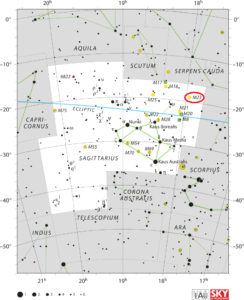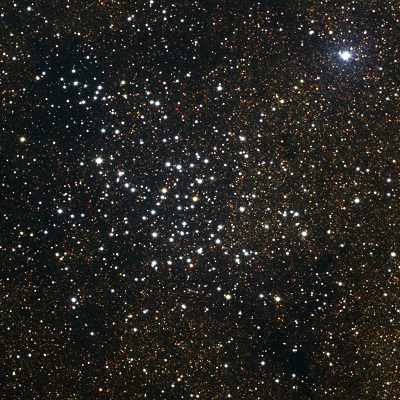Messier 23 is a bright, large open star cluster located in the constellation Sagittarius. M23 has an estimated age of at least 220 million years, which makes it one of the older known open clusters in our galaxy. Messier 23 occupies an area of 27 arc minutes of apparent sky, roughly the size of a full Moon and has a heavy concentration of stars.
| Description | |
| Visible From Pacific Northwest | April Through August |
| Best Time To Observe | August |
| Minimum Size Of Viewing Device | Binoculars |
| Object Type | Open Cluster |
| Designations | Messier 23, M23, NGC 6494, Collinder 356, C 1753-190, MWSC 2757 |
| Right Ascension | 17h 56.8m |
| Declination | -19°01′ |
| Constellation | Sagittarius |
| Number Of Stars | 176 |
| Apparent magnitude | +6.9 |
| Apparent dimensions | 27′ |
| Object Radius | 8 light years |
| Distance From Earth | 2,150 light years |
History
The open cluster was discovered by Charles Messier on June 20, 1764. Messier described the object as a “star cluster, between the end of the bow of Sagittarius & the right foot of Ophiuchus, very near to 65 Ophiuchi, according to Flamsteed. The stars of this cluster are very close to one another. Its position was determined from Mu Sagittarii. (diam. 15′)”
Locating M23 In The Sky
The cluster lies northwest of the Teapot asterism, formed by the brightest stars of Sagittarius. M23 is located just to the northwest of Mu Sagittarii, a multiple star system with an apparent magnitude of 3.84, visible to the naked eye. The cluster can be found 2.5 degrees north and 3.5 degrees west of the star.

Viewing M23
Messier 23 can easily be seen in binoculars and is best viewed in small and moderate-sized telescopes. 6-inch and 8-inch telescopes will resolve dozens of the cluster’s stars.
In binoculars, M23 appears as a hazy smudge with barely resolvable stars. Small telescopes at low magnifications will reveal the cluster’s brightest stars and HIP 87782, a particularly bright, magnitude 6.52 star appearing at the northwest corner of M23. HIP 87782 is a white main sequence star only 320 light years distant from the solar system. It is not a member of M23, but merely lies in the foreground of the cluster.
Photographing M23
As with any cluster of stars, precise auto guiding will be crucial as making sure the stars are crisp is crucial to any image. There aren’t a plethora of guides available for those looking to specifically imaging M23, as the best one could potentially find would be on astrobin or astropixels. It is definitely possible with a modified DSLR, but will require a telescope with guiding to track M23.
Sources And Further Reading
Descriptions of all of Messier Objects can be found here.
https://freestarcharts.com/messier-23

Be the first to comment on "Messier 23"